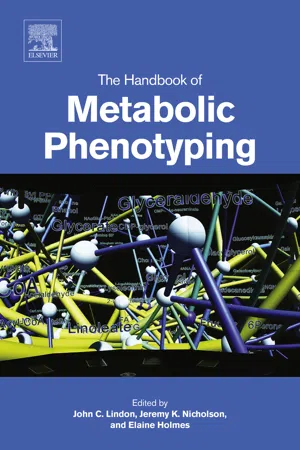
- 619 pages
- English
- ePUB (mobile friendly)
- Available on iOS & Android
The Handbook of Metabolic Phenotyping
About This Book
The Handbook of Metabolic Phenotyping is the definitive work on the rapidly developing subject of metabolic phenotyping. It explores in detail the wide array of analytical chemistry and statistical modeling techniques used in the field, coupled with surveys of the various application areas in human development, nutrition, disease, therapy, and epidemiology to create a comprehensive exploration of the area of study. It covers recent studies that integrate the various -omics data sets to derive a systems biology view. It also addresses current issues on standardization, assay and statistics validation, and data storage and sharing. Written by experts with many years of practice in the field who pioneered many of the approaches widely used today, The Handbook of Metabolic Phenotyping is a valuable resource for postgrads and research scientists studying and furthering the field of metabolomics.
- Contains theoretical and practical explanations of all the main analytical chemistry techniques used in metabolic phenotyping
- Explores, in detail, the many diverse statistical approaches used in the field
- Offers practical tips for successfully conducting metabolic phenotyping studies
- Features reviews of all of the various fields of activity relating to human studies
Frequently asked questions
Information
An Overview of Metabolic Phenotyping and Its Role in Systems Biology
Abstract
Keywords
1 The History and Evolution of Metabolic Profiling
1.1 The Early Years

1.2 Modern Metabolic Profiling Using NMR Spectroscopy
Table of contents
- Cover image
- Title page
- Table of Contents
- Copyright
- Contributors
- Foreword
- Preface
- Chapter 1: An Overview of Metabolic Phenotyping and Its Role in Systems Biology
- Chapter 2: NMR Spectroscopy Methods in Metabolic Phenotyping
- Chapter 3: The Role of Ultra Performance Liquid Chromatography-Mass Spectrometry in Metabolic Phenotyping
- Chapter 4: GC-MS-Based Metabolic Phenotyping
- Chapter 5: Metabolic Phenotyping Using Capillary Electrophoresis Mass Spectrometry
- Chapter 6: Supercritical Fluid Chromatography for Metabolic Phenotyping: Potential and Applications
- Chapter 7: The iKnife: Development and Clinical Applications of Rapid Evaporative Ionization Mass Spectrometry
- Chapter 8: Univariate Statistical Modeling, Multiple Testing Correction, and Visualization in Metabolome-Wide Association Studies
- Chapter 9: Multivariate Statistical Methods for Metabolic Phenotyping
- Chapter 10: Data-Driven Visualizations in Metabolic Phenotyping
- Chapter 11: Big Data and Databases for Metabolic Phenotyping
- Chapter 12: Progress in Standardization of Metabolic Phenotyping Data
- Chapter 13: Conception, Implementation and Operation of Large-Scale Metabolic Phenotyping Centres: Phenome Centres
- Chapter 14: Applications of Metabolic Phenotyping in Pharmaceutical Research and Development
- Chapter 15: Metabolic Phenotyping in Nutrition Research
- Chapter 16: Metabolic Phenotyping in Clinical Practice
- Chapter 17: Applications of Metabolic Phenotyping in Epidemiology
- Chapter 18: Influence of the Human Gut Microbiome on the Metabolic Phenotype
- Chapter 19: Linking Metabolic Phenotyping and Genomic Information
- Chapter 20: Metabolic Phenotyping: History, Status, and Prospects
- Index